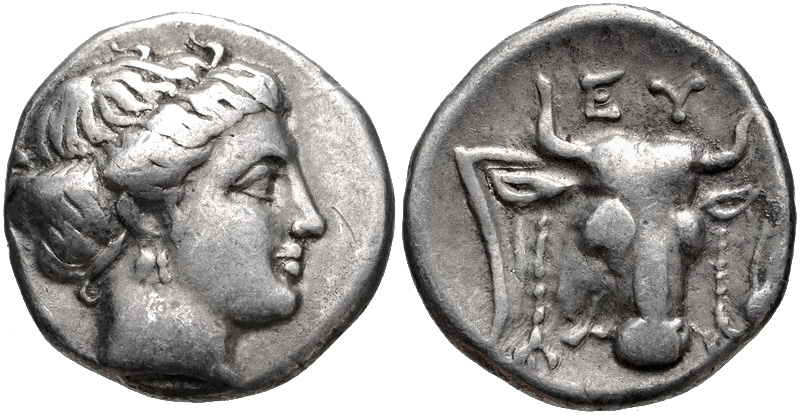H 147 - Euboea (uncertain mint) (Euboean League), silver, drachms (302-290 BCE)
From SILVER
302 BCE - 290 BCE Silver 1,977 kg
Description
| ObverseInscription or printing placed on the obverse.: | Head of nymph Euboea right. |
| ReverseInscription or printing placed on the reverse.: | EY (Greek).Head of bull right, fillets from horns, lyre to right. |
Mint and issuing power
| MintIdentifies the place of manufacture or issue of a numismatic object.: | Euboea (uncertain mint) | Ancient regionAncient region.: | Euboea | Modern countryModern country: Greece | AuthorityIdentifies the issuing power. The authority can be "pretended" when the name or the portrait of X is on the coin but he/she was not the issuing power. It can also be "uncertain" when there is no mention of X on the coin but he/she was the issuing power according to the historical sources: | Euboean League |
Chronology
| FromIdentifies the initial date in a range assigned in a numismatic context. | 302 BCE | toIdentifies the final date in a range assigned in a numismatic context.. | 290 BCE | PeriodTime period of the numismatic object.: Hellenistic 323-30 BC |
Physical description
| MetalThe physical material (usually metal) from which an object is made.: | Silver |
Median weightMedian of the weights of numismatic objects (in grams). in grams | 3.70 | DenominationTerm indicating the value of a numismatic object. Examples: tetradrachm, chalkous, denarius.: | drachma |
StandardStandard.: |
Image

H147 Nymph Euboea bull.jpeg [1]
References
| Die study referencePublication of the study: | Wallace 19561Wallace 1956 | ||
| Coin series referenceReference to coin series study: | RQEMH2RQEMH, n° 147, HGC 43HGC 4, n° 1421 | ||
Obverse dies distribution
| FrequencyFrequency of specimen in distribution. ᵖ | Number of obversesNumber of obverse dies. ᵖ (o) | % (o) | Number of coinsNumber of coins. (n) | % (n) | Die nameName(s) of the die(s). |
| 1 | 3 | 10.71 | 3 | 30, 33, 34 | |
| 2 | 1 | 3.57 | 2 | 55 | |
| 4 | 1 | 3.57 | 4 | 49 | |
| 5 | 1 | 3.57 | 5 | 47 | |
| 8 | 1 | 3.57 | 8 | 37 | |
| 13 | 1 | 3.57 | 13 | 48 | |
| 16 | 2 | 7.14 | 32 | 40, 50 | |
| 20 | 1 | 3.57 | 20 | 39 | |
| 25 | 1 | 3.57 | 25 | 32 | |
| 27 | 1 | 3.57 | 27 | 56 | |
| 29 | 1 | 3.57 | 29 | 31 | |
| 30 | 1 | 3.57 | 30 | 52 | |
| 34 | 1 | 3.57 | 34 | 46 | |
| 45 | 1 | 3.57 | 45 | 85 | |
| 51 | 1 | 3.57 | 51 | 51 | |
| 53 | 1 | 3.57 | 53 | 44 | |
| 61 | 1 | 3.57 | 61 | 57 | |
| 68 | 1 | 3.57 | 68 | 42 | |
| 72 | 2 | 7.14 | 144 | 36, 43 | |
| 78 | 1 | 3.57 | 78 | 41 | |
| 85 | 2 | 7.14 | 170 | 35, 45 | |
| 107 | 1 | 3.57 | 107 | 53 | |
| 118 | 1 | 3.57 | 118 | 38 | |
| Total | 28 of 28 | 99.96 | 1127 of 1,109 |
Reverse dies distribution
no distribution is available
Quantification
| Number of obversesNumber of obverse dies. ᵖ (o) | 28 | Number of singletons (o1)The number of singleton coins. ᵖ | 3 |
| Number of reverse diesNumber of reverse dies. (r) | 44 | Number of coinsNumber of coins. (n) | 1109 |
| Coins per obverse dieNumber of coins per obverse die. (n/o) | 39.61 | Coins per reverse dieNumber of coins per reverse die. (n/r) | 25.2 |
| Reverse per obverse ratioRatio of obverse dies divided by reverse dies. (r/o) | 1.57 | Percentage of singletons (o1)number of coins (n) divided by the number of singletons (o1) ᵖ | 10.71 % |
| Original number of dies (O) (Carter 1983 formula)The estimation of the number of coins according to Carter 1983 ᵖ | 26.72 | Coins struck if 20,000 as average productivity per dieCoins made if the average productivity for obverses (according to Carter) is 20,000. ᵖ | 534,400 |
| Original number of dies (O) (Esty 2011 formula)The estimation of the number of coins according to the singleton formula in Esty 2011 ᵖ (O) | 28.73 | Survival rate if 20,000 as average productivity per dieSurvival rate if average productivity is 20,000. ᵖ | 0.00208 |
| Coverage (o = % of O) (Esty 1984 formula)Esty 1984 - coverage (% of O) ᵖ (o = % of O) | 99.73% | Die productivity if survival rate 1/2,000Average productivity if survival rate is 1/2,000. ᵖ | 83,008.98 |
| Weight of silver (in kg) if 20,000 coins per die (O = Carter formula)Carter 1983 * Median weight * 20000 (*10 if gold or electrum) ᵖ | 1,977 kg <br /> 1,977 kg | Die productivity if survival rate 1/5,000Average productivity if survival rate is 1/5,000. ᵖ | 207,522.46 |
Remarks